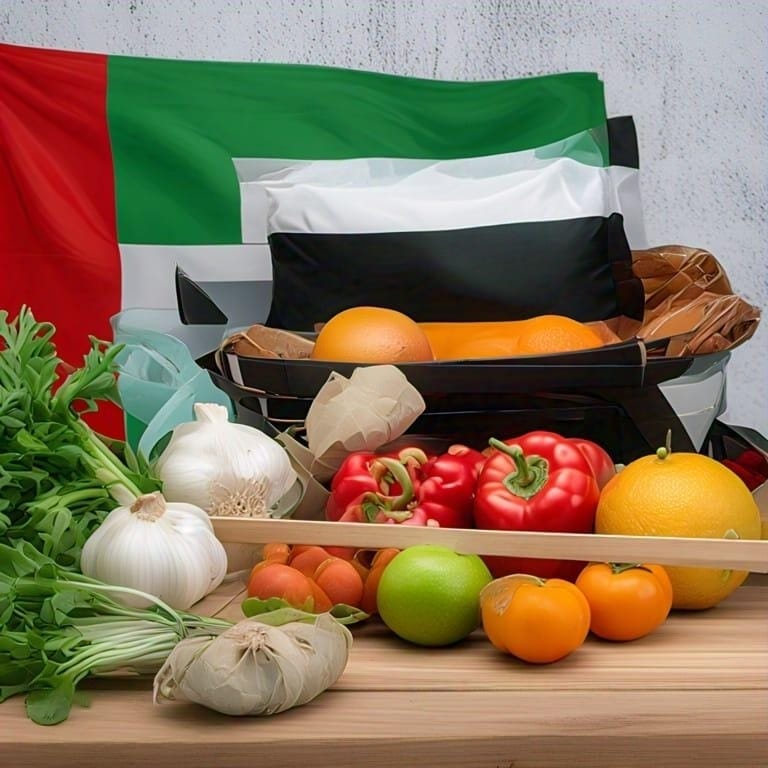How to Import Fruits and Vegetables into the UAE 2025
Table of Contents
The UAE’s strategic location and world-class logistics infrastructure make it a prime hub for food imports, Such as spices, sugar, gulkand, etc. & agriculture products including fruits and vegetables. In this article we will discuss on how to import Fruits & Vegetables into UAE to start a successful business.
Every business need to follow rules and regulation to make a sustainable environment. Government regulations, especially in industries like food, health, and safety, ensure that products meet certain standards. Complying with these regulations helps maintain the quality and safety of products, which builds consumer trust. Businesses that follow these rules demonstrate a commitment to ethical practices and consumer welfare, leading to a stronger brand reputation.
1. Choose Trusted Exporters
Partnering with a reliable exporter is crucial. Look for companies with a proven track record of quality and compliance. From trusted exporters ensure that all products are sourced and handled with care, meeting international quality standards and regulations.
2. Select Quality Products Wisely
The quality of the fruits and vegetables is essential for building a strong market presence. Make sure to select products that are fresh, properly packaged, and meet the quality requirements of the UAE. Choose exporters who prioritize quality checks and maintain stringent standards.
3. Opt for a Sustainable Logistics Partner
Efficient and sustainable logistics are key to ensuring timely delivery without compromising timing of delivering goods. Work with logistics partners that offer cold chain solutions, efficient packaging, and eco-friendly practices. This can significantly reduce transit delays and spoilage, ensuring the products reach their destination fresh.
4. Ensure Proper Documentation
Documentation is a critical part of the import process. Make sure all paperwork, including health certificates, permits, and other necessary documents, are accurately completed and cleared by the relevant government authorities. This prevents delays and ensures compliance with UAE regulations.
5. Understand Regulatory Authorities
The UAE has a comprehensive regulatory framework for food imports, ensuring safety, quality, and compliance. Key regulatory bodies include:
- Ministry of Climate Change and Environment (MOCCAE): Oversees food safety standards, including sanitary and phytosanitary measures, labelling requirements, and the regulation of high-risk products.
- Emirates Authority for Standardization and Metrology (ESMA): Develops technical regulations for food quality, packaging, and halal certification.
- Local Municipality Authorities (e.g., Dubai, Abu Dhabi): Handle product registration, inspections, and testing at ports of entry
- Product Registration and Documentation
Before importing, all new food products must be registered with the local authorities. The registration process involves label review and sometimes lab testing. The necessary documents include:
- Commercial Invoice
- Bill of Lading
- Certificate of Origin
- Health Certificate issued by relevant authorities from the exporting country
- Import Permit (specific to the product category)
Each product must have a unique barcode linked to the national registry for traceability. Products should also comply with labelling requirements, displaying information in both Arabic and English
6. Labelling Requirements
All imported food products, including fruits and vegetables, must have proper labels. Essential labelling information includes:
- Product name and brand
- List of ingredients
- Manufacturer’s details
- Country of origin
- Production and expiration dates
- Nutritional information
The labels should be bilingual (Arabic and English), and stickers can be used for translation purposes. It’s important to strictly follow these guidelines to avoid delays during customs clearance
7. Inspection and Testing
Once the shipment arrives, it undergoes a risk-based inspection process. This involves:
- Document Verification: Checking the accompanying paperwork to ensure compliance.
- Physical Inspections: Verifying that packaging and labeling match the declared details.
- Sampling for Lab Tests: Authorities may randomly sample shipments to test for contaminants, allergens, and compliance with food safety standards. Depending on the risk classification (high, medium, low), the level of inspection varies
- Customs Duties and Fees
Importers must be aware of applicable customs duties, taxes, and fees. While many fruits and vegetables are exempt from import duties, processed food products may attract a 5% duty as per GCC regulations. Fees can vary based on factors like product type, origin, and quantity. Properly budgeting for these expenses is crucial for cost-effective imports. (Please concern local govt. authorities for more information)
8. Halal Certification
If importing products labeled as halal, they must comply with ESMA’s halal certification standards. Certification ensures that the food product meets all requirements of Islamic dietary laws, making it suitable for the UAE market.
9. Stay Updated with Regulations
Food import regulations can frequently change. Regularly checking updates from government websites, local authorities, or consulting with logistics and compliance experts can help avoid costly delays. Staying informed on the latest standards will ensure smooth processing of future shipments.
By following these steps and adhering to all regulatory requirements, you can effectively import fruits and vegetables into the UAE, expanding your business into this thriving market.
For more information you can also take a quotes from www.aromaxport.com & you can find us on LinkedIn: aromaxport.
article by: aagamvejani.com



